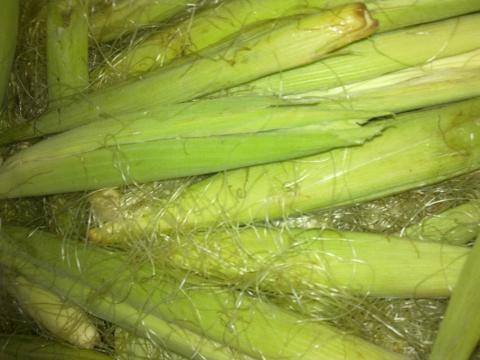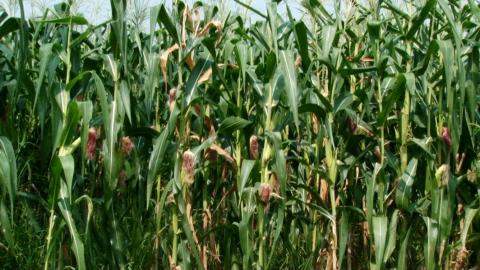Utilization of baby corn by-products and waste as livestock feed
By Mohinder P.S. Bakshi, M. Wadhwa and Harinder P.S. Makkar*
Department of Animal Nutrition, Guru Angad Dev Veterinary and Animal Science University, Ludhiana-141004, India; *International Consultant and Adjunct Professor, University of Hohenheim, Stuttgart, Germany
E-mail: bakshimps2@gmail.com
Introduction
The production of fresh vegetables including baby corn has increased from 239.7 to 279.7 million tonnes during the period from 2003 to 2013 (FAO, 2015) and it would continue to increase in the future. This would make available increasing amounts of various non-food parts and by-products of vegetables, which can be used as animal feed. Use of such human-inedible parts from agricultural products as animal feed will not only enhance food security but also contribute to alleviation of environmental problems associated with their disposal.
Except during peak winter months, baby corn is cultivated throughout the year in India. On an average four crops of baby corn are taken per annum. The production of baby corn has increased remarkably in the last decade. In India, the average baby corn production is about 7.5–8.7 tonnes/ha.
Of this the human-edible husked baby corn cob is only 15%, while the remaining 85% constitutes of outer peel/husk with a silky thread-like structure called baby corn husk with silk (Photo 1).
Photo 1: Baby corn husk with silk. (Photo credit: M.P.S. Bakshi)
Another by-product is green stalks with leaves, also called baby corn fodder (Photo 2) (Bakshi et al., 2016).
Photo 2: Baby corn fodder ready for harvesting. (Photo credit: M.P.S. Bakshi)
Baby corn crop after 55-60 days of sowing is ready for picking baby corn cobs for human consumption. Three to four baby corn ears are hand-picked as soon as 2-3 cm silk emerges from the ear tips. The husk and silk are removed from the baby corn cob. The husked cobs are cut to specific size in the food processing plant and then sent abroad or to domestic market for human consumption. The husked young ears of baby corn are eaten either fresh, as salad, in soup, or as vegetable and is considered a delicacy. The husk with silk constitutes 85-90% of the ear. The average yield of baby corn husk with silk is 5-5.5 tonnes/ha. Baby corn husk with silk is chopped for feeding to livestock.
Fresh baby corn husk with silk
The fresh baby corn husk with silk and conventional maize fodder contain 94.3 and 91.8% organic matter (OM), 11.7 and 8.6% crude protein (CP), 62.0 and 68.0% neutral detergent fiber (NDF), 27.0 and 41.5% acid detergent fiber (ADF), 24.0 and 33.0% cellulose, and 35.0 and 26.0% hemicellulose, respectively (Bakshi and Wadhwa, 2012). Fresh baby corn husk and silk portion is highly relished by animals and an adult large cow can consume 45-50 kg/day. As compared to conventional maize fodder, fresh baby corn husk has higher (P<0.05) digestibility of nutrients, N-retention and efficiency of N-utilization in buffalo calves (Table 1).
| Parameter | Maize fodder | Baby corn husk | PSE |
| Digestibility of nutrients, % | |||
| DM* | 61.7a | 72.63b | 2.43 |
| NDF* | 58.0a | 71.5b | 3.0 |
| Cellulose* | 67.1a | 77.8b | 2.3 |
| Hemicellulose** | 58.6a | 77.2b | 3.5 |
| N-balance, g/day | |||
| N-Intake | 60.6 | 66.3 | 2.5 |
| Faecal-N | 17.2 | 17.0 | 1.0 |
| Urinary-N | 19.6 | 17.2 | 7 |
| N-retained | 23.8 | 32.2 | 2.6 |
| Apparent Biological Value, % | 54.9 | 64.6 | 3.8 |
Figures with different superscript in a row differ significantly, **P<0.01; *P<0.05; PSE: Pooled standard error.
Table 1. Digestibility of nutrients and nitrogen-retention in buffalo calves fed green maize fodder or fresh baby corn husk. Source: Bakshi and Wadhwa, 2012.
Ensiled baby corn husk with silk
It can be ensiled after wilting for few hours during summers or 1-2 days during winters. After wilting, these are chopped and ensiled for 42 days in low density polyethylene tube of approximately 6 feet diameter and 10-12 feet length. After thorough pressing the chopped husk with clean feet, the polyethylene tube is tied with nylon string at the top.
After 42 days, the tube silo is opened from the top and the ensiled husk with silk is taken out as per the daily requirement, and the tube is tied again. The spraying of water soluble silage inoculum containing Lactobacillus spp. (1x1011 colony forming units (cfu)/g) hastens pH drop during ensiling. It is being used at 1 g/tonne of the green fodder by some farmers. The ensiled baby corn husk can be incorporated in the total mixed ration (TMR) of ruminants up to 30% on dry matter basis.
Baby corn fodder
After taking 3-4 baby corn ears, the leftover by-product available is the young green fodder, which can also be used for animal feeding. The yield of green baby corn fodder varies between 30-35 tonnes/ha, depending on the type of cultivar. An adult cow can consume 40-45 kg fresh, chaffed green fodder. The baby corn fodder and conventional maize fodder have comparable chemical composition except that the former has higher CP (10-11% vs. 9.2-10%) and OM (92.4% vs.91.5%). The in vitro evaluation revealed that baby corn fodder had higher (P<0.05) digestibility of nutrients, total volatile fatty acid (VFAs) production and metabolizable energy (ME) availability as compared with the conventional maize fodder (Bakshi et al., 2017). The baby corn fodder has higher digestibility and nutritional value than conventional maize fodder (Table 2).
| Parameter | Maize (J-1006) fodder | Baby corn fodder | PSE |
| DM intake, kg/day | 8.23 | 8.96 | 0.2 |
| Digestibility of nutrients, % | |||
| DM | 56.6 | 62.8 | 1.5 |
| CP | 70.7 | 73.1 | 1.3 |
| NDF | 54.0 | 60.3 | 1.5 |
| Cellulose | 60.0 | 65.4 | 1.3 |
| N-retention, g/day | |||
| N-intake | 121.7 | 145.6 | 1.8 |
| Faecal-N | 33.9 | 39.9 | 1.8 |
| Urinary-N | 35.8 | 28.4 | 1.8 |
| N-retained | 52.1 | 77.4 | 2.7 |
| ABV, % | 59.3 | 73.2 | 1.8 |
ABV: Apparent biological value
Table 2. Digestibility of nutrients and nitrogen-retention in maize and baby corn fodder fed ad libitum to male buffaloes. Source: Bakshi et al., 2017.
Baby corn fodder can be conserved by ensiling in pits, tube silos or in bales in varying amounts (60 to 450 kg).
Small farmers harvest the baby corn fodder manually and leave them in the field for wilting and then subject it to chaffing. Large farmers harvest baby corn fodder by using a tractor operated single-row or self-propellant multiple-row harvester. Besides harvesting the fodder, these machines chaff the fodder and shred the corn grains simultaneously. The only difference is that the single-row harvester has a capacity of harvesting 0.1-0.3 hectare/day, and the multiple-row harvester has a capacity of harvesting 7-8 hectare/day. The chaffed fodder is simultaneously loaded in a tractor trolley. The trolley is unloaded by hydraulic system. The chaffed fodder is then transferred to the hopper of a semi- or fully-automatic baling machine for making bales. These bales are highly compact with high density (450 to 500 kg/m3) and are kept for 42 days ensiling. This automatic baler can make 30-40 bales/hour of 450 to 500 kg each. The costs in US$ of these single-row and multiple-row harvesters and automatic baling machine are approximately 5,000; 230,000 and 190,000 respectively.
The ensiled baby corn fodder is mixed with other feedstuffs such as straw, green fodder, concentrate ingredients and feed additives and fed as TMR round-the-year. The ensiled baby corn fodder can be incorporated up to 30% in the ration of ruminants. The TMR containing ensiled baby corn fodder had nutritive value comparable with that of conventional maize fodder (Table 3) when tested in male buffalo calves (Wadhwa et al., 2017). In dairy animals, it resulted in higher milk yield and higher solid-not-fat compared with that obtained on feeding conventional maize silage.
| Parameter | TMR-1 | TMR-2 | PSE |
| DM intake, kg/day | 4.88 | 4.98 | 0.23 |
| Digestibility of nutrients, % | |||
| DM | 52.7 | 56.8 | 3.5 |
| CP | 71.3 | 70.1 | 1.8 |
| NDF | 25.9 | 3.0 | 8.8 |
| Cellulose | 45.2 | 5.0 | 7.5 |
| N-retention, g/day | |||
| N-intake | 113.2 | 118.5 | 7.2 |
| Faecal-N | 31.9 | 35.6 | 2.1 |
| Urinary-N | 35.7 | 38.3 | 1.2 |
| N-retained | 45.5 | 44.6 | 4.5 |
| ABV, % | 54.8 | 53.0 | 2.4 |
TMR-1: Contained ensiled maize fodder; TMR-2: Contained ensiled baby corn fodder; ABV: Apparent biological value.
Table 3. Digestibility of nutrients and nitrogen retention in male buffalo calves fed ensiled maize and baby corn fodder in total mixed ration (TMR). Source: Wadhwa et al., 2017.
The baby corn cultivation serves as a dual-purpose crop. The cultivation of baby corn has been highly remunerative to the farmers: besides selling baby corn cobs for human consumption, they can use/sell baby corn husk with silk, and baby corn fodder as animal feed.
References
- Bakshi, M.P.S. and Wadhwa, M. 2012. Nutritional evaluation of baby corn husk - A new feed resource for livestock. Indian Journal of Animal Science, 82: 1548-1550.
- Bakshi, M.P.S., Wadhwa, M. and Makkar, H.P.S. 2016. Wastes to worth: vegetable wastes and by-products as animal feed. Commonwealth Agriculture Bureau Reviews, 11: No. 012.
- Bakshi, M.P.S., Wadhwa, M. and Balwinder Kumar. 2017. Nutritional evaluation of baby corn fodder and conventional maize fodder in buffaloes. Livestock Research for Rural Development. Volume 29, Article #141. http://www.lrrd.org/lrrd29/7/baks29141.html
- FAO. 2015. FAOSTAT Statistical Database. Rome. Available from: faostat.fao.org.
- Wadhwa, M., Balwinder Kumar and Bakshi, M.P.S. 2017. Nutritional evaluation of ensiled baby corn fodder as livestock feed. Animal Nutrition and Feed Technology, 17: (in press).



